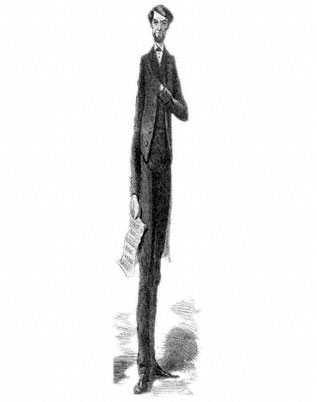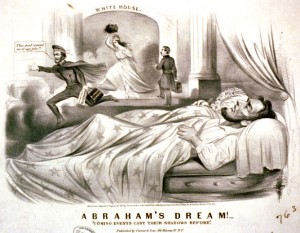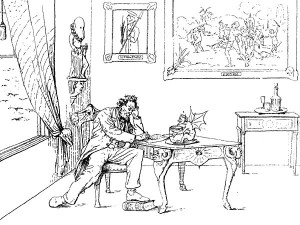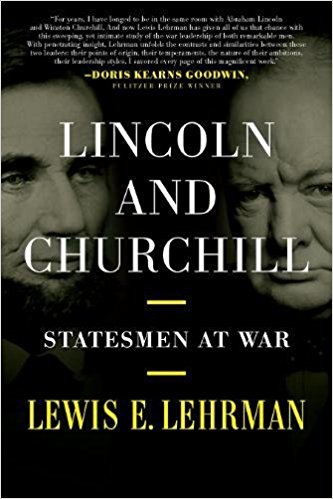President Lincoln enjoyed humor. Many Americans enjoyed making fun of President Abraham Lincoln.
Some of the most recognizable cartoons were published in Harper’s Weekly, a New York City periodical that also featured sketches of war scenes and famous personalities – as well as news and serialized literature. Among its illustrators were Winslow Homer (who also worked for the Illustrated Times) and Alfred Waud. The leading illustrator of Harpers Weekly was Thomas Nast, who contributed beautiful illustrations to Harpers for more than three and a half decades, beginning in 1859. In 1859, Nast also began contributing unsigned and less sophisticated cartoons to the new, New York monthly, Phunny Phellow – which he continued to do for more than a decade.
Nast also drew for Frank Leslie’s Illustrated News, for whom he started work in 1856. The periodical began the Civil War as an anti-abolition, pro-Southern journal but moved to support of the Union after Fort Sumter. As a twenty-one year-old, Nast drafted straightforward sketches of President Lincoln’s movement through Baltimore and President Lincoln’s First Inaugural – as well as his first political cartoon of Northern and Southern reactions to the inauguration. That Nast’s drawings are generally without text is unsurprising – he could neither read nor write.
Before the Civil War, Nast had sketched European events for Leslie’s and the New York Illustrated News, a chronically understaffed and underfunded periodical whose staff he joined in 1859. He later gained fame for his cartoon attack on New York political corruption personified by Boss Tweed and his annual Christmas engravings featuring Santa Claus. But during the Civil War he was known more for beautiful, nonpolitical sketches than cartoons, which he did anonymously. President Lincoln reportedly said: “Thomas Nast has been our best recruiting sergeant.”
Like fellow illustrators Louis Maurer and Adalbert Volck, Nast was born in Germany. Frank Bellew, who also worked for Harpers, Frank Leslie’s, The Comic Monthly and Scribner’s Magazine, was born in India of English parents. Charles Dickens wrote of Bellew, who emigrated to the United States in 1850, “Frank Bellew’s pencil is extraordinary. He probably originated more, of a purely comic nature, than all the rest of the artistic brethren put together.”
Also published in New York City was Vanity Fair, which styled itself after Punch of London and was almost as critical of Mr. Lincoln as its English counterpart. It made considerable fun of President-elect Lincoln’s surreptitious trip through Baltimore to avoid an assassination attempt in February 1861. Another favorite target of Vanity Fair cartoons was New York Tribune editor Horace Greeley. The illustrations of Henry Louis Stephens, the art director, whose work ran from 1859 until 1863, were even tougher on black Americans, who were portrayed in unflattering lights and looks. Sometimes, as in “The Monstrous Minstrel” published in September 1862, Stephens picked on Lincoln, Greeley and blacks at the same time. Stephens, whose brothers ran Vanity Fair, also worked for Frank Leslie, who had recruited him to come to New York City.
Louis Maurer, a German immigrant worked primarily for Currier & Ives, a producer of lithographed prints. Although he quit working full-time for the firm in 1860 and earned money during the Civil War as a firearms instructor, Maurer continued to produce cartoons for Currier & Ives-such his “Abraham’s Dream” in 1864. This was a relatively simple cartoon. His work was often marked by large blocks of text and dialogue. He later became known for his images of firefighters and horses.
London’s Punch itself was usually dismissive of President Lincoln. The President’s chief tormenter was Sir John Tenniel, whose cartoons betrayed upper class British contempt for the American democratic experiment. After President Lincoln’s assassination, however, Tenniel composed a simple cartoon, “Britannia Sympathises with Columbia.” After the Civil War, Tenniel did the illustrations for Alice’s Adventures in Wonderland by Lewis Carroll. The London Fun’s Matt Morgan was similarly anti-Lincoln and even more heavy-handed in his portrayal.
One of the most anti-Lincoln caricaturists in America was Aldabert John Volck – a Baltimore dentist who penned a cartoon of the President-elect sneaking out of a freight car while a cat looked on. (http://www.civilwar.si.edu/lincoln_passage_baltimore.html) His wordless commentaries on Lincoln were signed V. Blada, a portion of his name spelled in reverse. The Bavarian-born Volck’s most famous attack may have been his portray of President Lincoln trampling the Constitution underfoot while writing the Emancipation Proclamation with ink from the Devil’s inkpot. From the wall, abolitionist John Brown looks on approvingly from underneath a halo. After the Civil War, Volck worked as a portrait painter.
There were fewer southern outlets for cartoons – and less newspaper to print them. The most prominent was the Southern Illustrated News, published in Richmond.
Some cartoons during the Civil War were overtly political – published by political campaigns themselves in the 1860 – such as The Railsplitter printed in 1860 and The Dial printed in 1864.
For more cartoons, visit Abraham Lincoln’s Classroom by clicking here.






